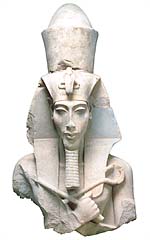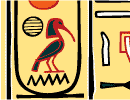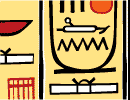By POLLY SHULMAN
 GYPT puts the
millennium in perspective. For 3,000 years before Christianity
jump-started our calendar, civilization flourished along the Nile.
People brewed beer, hewed rocks into huge statues of their kings and
gods, and tried to keep the hippopotamuses from ruining their crops.
With its towering pharaohs, its cool linen and its
expressive typography, Ancient Egypt has a special,
favored place in the modern Western imagination.
GYPT puts the
millennium in perspective. For 3,000 years before Christianity
jump-started our calendar, civilization flourished along the Nile.
People brewed beer, hewed rocks into huge statues of their kings and
gods, and tried to keep the hippopotamuses from ruining their crops.
With its towering pharaohs, its cool linen and its
expressive typography, Ancient Egypt has a special,
favored place in the modern Western imagination.
|

Museum of Fine Arts, Boston
|
The remains of the colossal statue
of Amenhotep IV, for Karnak, Egypt. He reigned from 1353
to 1336 B.C. The statue will be on view in Boston.
|
In contrast
to how we view the ancient Hebrews, from whom our religions are
descended, or the ancient Greeks and Romans, who left an
intimidating cultural legacy, we feel we owe the Egyptians nothing --
a much better basis for wholehearted love. Yet their long history,
their written records, their practice of providing the dead with
everything they might need in the afterlife (and the closet space to
go with it) and their peculiar climate, which preserved it all, give
us the means of getting to know them.
Strangely inscrutable, strangely accessible, strangely vulnerable,
Egypt holds sway as a sort of fascinating uncle with an
attic full of treasure but no authority to send us to school. Can we
rifle that attic like naughty children, bearing away objects and ideas
that we don't quite understand? An endless stream of mummy-revenge
movies flickering across our century suggests our ambivalence about
such co-option.
Of all ancient cultures, Egypt is the one that most
rewards ignorance.
With their hawks and ducks, their hands, eyes, lions, walking legs,
jugs and rolls of linen, hieroglyphics offer the impression of
significance even to people who can't read them. It's fun to read
mystical meaning into the symbols, as pretty much all Western viewers
did until 1822, when Jean- François Champillion deciphered the old
script on the Rosetta Stone. Renaissance scholars were sure the
papyruses and carvings contained hidden wisdom or powerful spells.
That their interpretations proved to be nonsense barely detracts from
the power of dramas based on supposed Egyptian mysteries, from "The
Magic Flute" to "The Mummy."
Two exhibitions this fall, one at the Metropolitan Museum of Art in
New York and the other at the Museum of Fine Arts in Boston, will give
visitors a chance to read what they like into Egypt's treasures
-- or, if they prefer, to learn from the work of scrupulous scholars.
Both exhibits focus on periods of powerful leaders and exciting
artistic advances. And if those two aren't enough Egypt for
you, there's plenty more a gallery over or a subway ride away.
With more than 30 rooms of top-notch Egyptian treasures in the
Met's permanent collection and more than a floor's worth at the
Brooklyn Museum of Art, New York is one of the world centers of
Egyptian art. New Yorkers can tour the land of the pyramids without
even a camel, following in the footsteps of Western visitors since
Herodotus.
"I shall now speak of Egypt, because this country possesses
many marvelous things and offers monuments that beggar description,
being more magnificent than those of any other country," wrote the
Greek historian. The pyramids were already more than 2,000 years old
when he visited them in the fifth century B.C.
To Westerners who followed Herodotus, from Alexander the Great to
Napoleon and beyond, Egypt was a land of vast, mysterious
monuments and toppled kings. According to one story, the idea for
Shelley's poem "Ozymandias" came from 18th-century descriptions of
monuments at Luxor. (Another story has it that he was inspired by the
mammoth red granite head of Amenophis III in the collection of
Egyptian sculpture at the British Museum.) He wrote, in part:
"My name is Ozymandias, king of kings:
Look on my works, ye
Mighty, and despair!"
Nothing beside remains. Round the decay
Of that colossal wreck, boundless and bare,
The lone and level
sands stretch far away.
Egypt was also, of course, a never-ending source of
deliciously venerable souvenirs.
"Egyptian Art in the Age of the Pyramids," which opens Thursday at
the Metropolitan, offers visitors a glimpse of "marvelous things" and
toppled kings. The pharaohs of the Old Kingdom, which lasted from 2650
to 2150 B.C., were considered semi-divine beings who had the ear of
the gods -- and looking at the art they left behind, it's easy to see
why.
Artists working under them were responsible not only for the
pyramids, those icons of Egypt, but for grand, powerful images
carved, painted or molded from a vast array of materials -- stone,
wood, precious metals, clay. In one gorgeous sculpture, a pair of
goddesses flanks King Menkaure, their shoulders slightly behind his.
Hathor, the goddess of love, holds his hand as he steps forward with
his left foot, not quite smiling. (The pose -- left foot forward,
hands by the sides -- lasted for more than 2,500 years, showing up in
statue after statue, until the elegant slouches of Greece and Rome
infected Egyptian posture.) A monumental seated statue of Hemiunu, a
portly man getting on in years, puts a personal face on the Great
Pyramid at Giza. He was not only a relative of King Khufu, who was
buried there, but probably the architect who designed it. And though
they couldn't bring the whole pyramid over, the curators include one
of its stones.
The Boston exhibit, "Pharaohs of the Sun: Akhenaten, Nefertiti,
Tutankhamen," skips ahead some 750 years to a revolutionary moment.
After the Pharaoh Akhenaten assumed the throne in 1353 B.C., he
abandoned Egypt's traditional capitals, Memphis and Thebes, and
built himself a new city, Amarna. There he overturned the old
religion, ousting the gods and goddesses of the canon -- especially
the chief god, Amen -- and replacing them with a single deity: Aten,
"the light of the sun." The art that flourished under this visionary
king had a new, personal quality. After millenniums of stylized
monarchs with broad shoulders and sternly serene faces, Akhenaten
shows up in statues and reliefs sporting a skinny chest, a pot belly
and weirdly long facial features. On one stele, he and his queen,
Nefertiti, hold wiggling daughters in their laps and arms, a playful
depiction no previous pharaoh would have allowed.
Akhenaten's revolution didn't last long. After his death and that
of his successor -- a shadowy figure who may have been Nefertiti, and
in any case ruled for only four years -- the young king Tutankhamen,
Akhenaten's son-in-law, gave it up. He moved the capital back to
Thebes, abandoned Aten and restored Amen and his priests.
Tutankhamen is, of course, King Tut, the world's most famous mummy,
whose spectacular discovery in 1922 by Howard Carter inspired all
those ominous movies (as well as a number of flapper outfits and
dances). Carter's account of his find, with its combination of awe,
respect, excitement and desire, perfectly captures our uneasy
exhilaration about capturing the past:
"I suppose most excavators would confess to a feeling of awe --
embarrassment almost -- when they break into a chamber closed and
sealed by pious hands so many centuries ago. Three thousand, four
thousand years maybe, have passed and gone since human feet last trod
the floor on which you stand, and yet, as you note the signs of recent
life around you -- the blackened lamp, the finger-mark upon the
freshly painted surface -- you feel it might have been but yesterday.
The very air you breathe, unchanged throughout the centuries, you
share with those who laid the mummy to its rest. Time is annihilated
by little intimate details such as these, and you feel an intruder.
That is perhaps the first and dominant sensation, but others follow
thick and fast -- the exhilaration of discovery, the fever of
suspense, the almost overmastering impulse, born of curiosity, to
break down seals and lift the lids of boxes, the thought -- pure joy
to the investigator -- that you are about to add a page to history,
the strained expectancy -- why not confess it? -- of the
treasure-seeker."
Polly Shulman is a contributing editor to Science magazine.





